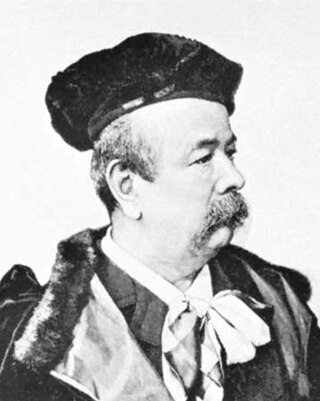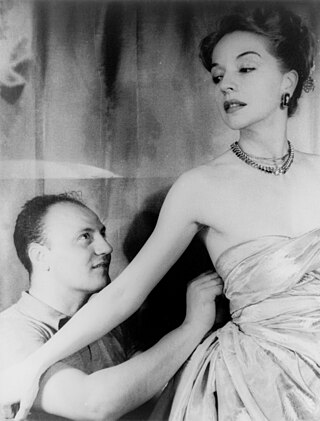Related Research Articles

Yves Henri Donat Mathieu-Saint-Laurent, referred to as Yves Saint Laurent or YSL, was a French fashion designer who, in 1962, founded his eponymous fashion label. He is regarded as being among the foremost fashion designers of the twentieth century. In 1985, Caroline Milbank wrote, "The most consistently celebrated and influential designer of the past twenty-five years, Yves Saint Laurent can be credited with both spurring the couture's rise from its 1960s ashes and with finally rendering ready-to-wear reputable."

Christian Ernest Dior was a French fashion designer, best known as the founder of one of the world's top fashion houses, Christian Dior SE, which is now owned by parent company LVMH. His fashion houses are known all around the world, having gained prominence "on five continents in only a decade."

Charles Frederick Worth was an English fashion designer who founded the House of Worth, one of the foremost fashion houses of the 19th and early 20th centuries. He is considered by many fashion historians to be the father of haute couture. Worth is also credited with revolutionising the business of fashion.

James Galanos was an American fashion designer and couturier. Galanos is known for designing clothing for America's social elite, including Nancy Reagan, Marilyn Monroe, Elizabeth Taylor, and others.
Arnold Isaacs, known as Arnold Scaasi, was a Canadian fashion designer who has created gowns for First Ladies Mamie Eisenhower, Barbara Bush, Hillary Clinton, and Laura Bush, in addition to such notable personalities as Joan Crawford, Ivana Trump, Princess Yasmin Aga Khan, Lauren Bacall, Diahann Carroll, Elizabeth Taylor, Catherine Deneuve, Brooke Astor, Arlene Francis, Mitzi Gaynor and Mary Tyler Moore.
Catherine Walker was a French-born fashion designer based in London. Born Catherine Marguerite Marie-Therese Baheux in Calais, France, Walker is known for having supplied over a thousand garments for Diana, Princess of Wales.

Redfern & Sons was a British tailoring firm founded by John Redfern (1820-1895) in Cowes on the Isle of Wight that developed into a leading European couture house. By the early 1890s the business had branches in London, Edinburgh, Paris and New York. The Paris extension was operated as a couture establishment while its other branches functioned primarily as tailors and importers.

Haute couture is the creation of exclusive custom-fitted high-end fashion design. The term "Haute couture" is derived from the French language, where "haute" means "high" or "elegant," and "couture" translates to "sewing" or "dressmaking." Bodice is a composition of vesture, traditionally for women and girls, covering the torso from the neck to the waist. The term Haute Couture generally refers to a specific type of upper garment common in Europe during the 16th to the 18th century, or to the upper portion of a modern dress to distinguish it from the skirt and sleeves. Beginning in the mid-nineteenth century, Paris became the centre of a growing industry that focused on making outfits from high-quality, expensive, often unusual fabric and sewn with extreme attention to detail and finished by the most experienced and capable of sewers—often using time-consuming, hand-executed techniques. Couture translates literally from French as "dressmaking", sewing, or needlework and is also used as a common abbreviation of haute couture and can often refer to the same thing in spirit. Haute translates literally to "high".

John Cavanagh was an Irish couturier of the 1950s and 1960s. A member of the Incorporated Society of London Fashion Designers (IncSoc), his style has been described as reflecting Parisian chic. He designed the wedding dresses for the Duchess of Kent in 1961 and for Princess Alexandra in 1963.

The history of Italian fashion is a chronological record of the events and people that impacted and evolved Italian fashion into what it is today. From the Middle Ages, Italian fashion has been popular internationally, with cities in Italy producing textiles like velvet, silk, and wool. During the Middle Ages and Renaissance, Italian fashion for both men and women was extravagant and expensive, but the fashion industry declined during the industrialization of Italy. Many modern Italian fashion brands were founded in the late 19th and early 20th centuries, and in the 1950s and 1960s, Italian fashion regained popularity worldwide. While many clients of Italian fashion designers are celebrities, Italian fashion brands also focus on ready-to-wear clothes.
Graham Smith is a milliner from Kent, England. Beginning his career at a time when hats were an everyday essential for fashionable women, he worked with leading couturiers in Paris and London, later establishing his own brand and also working with mainstream fashion brands such as Kangol.

Sir Edwin Hardy Amies KCVO was an English fashion designer, founder of the Hardy Amies label and a Royal Warrant holder as designer to Queen Elizabeth II.

The Incorporated Society of London Fashion Designers was a membership organisation founded in 1942 to promote the British fashion and textile industry and create luxury couture to sell abroad for the war effort. It aimed to build the relationship between government and fashion industry and represent the interests of London couturiers. The organisation continued after the war and sought to present itself as an alternative to the revived Paris couture industry.
Victor Edelstein is a British former couturier best known for his fashion designs for Diana, Princess of Wales, in the 1980s. In 1989 he was described as the English equivalent to Oscar de la Renta, and "the master of the English thoroughbred look". He now works as a painter.

Henry Digby Morton (1906–1983) was an Irish fashion designer and among the leading names of British couture in the period from 1930-50. He was also among the pioneers of ready-to-wear fashions in the 1950s. Successful on both sides of the Atlantic, he redefined women's suits and tailoring, earned himself the moniker 'Daring Digby' for his US fashion venture and helped to establish the Incorporated Society of London Fashion Designers, an early forerunner of the British Fashion Council.

Charles Southey Creed was a British fashion designer. Born into the longstanding tailoring house of Henry Creed & Company in Paris, he launched his eponymous label in London in 1946. The first elected member of the Incorporated Society of London Fashion Designers, he had success in both Britain and the United States.

Michael Sherard was a British fashion designer and a member of the Incorporated Society of London Fashion Designers, which represented the British couture industry in the wartime and post-war years. Operating his own label from the 1940s to 1960s, he is remembered primarily for his evening and occasion gowns. He also helped train future British designers, including Caroline Charles, and was later a design academic.

Michael Donnellan (1915–1985) – best known as Michael of Carlos Place and simply Michael – was an Irish-born fashion designer who headed the house of Lachasse from 1941, before running a successful eponymous couture house in London from 1953 to 1971. From the 1960s on, he combined the role of couturier with consultancy to mainstream fashion houses, most notably acting as a key consultant to Marks & Spencer.
Lachasse was a British couture firm operating from 1928 until 2006, making it one of the longest surviving high fashion houses in London.
Reed Crawford (1924-2006) was a British milliner of the 1950s and 1960s. He produced a series of high-fashion designs that matched the Swinging London mood of the 1960s, including helmet-style cloche hats and designs in unusual material combinations, such as plastic and fur. He became especially associated with couture, working with the designer John Cavanagh from 1959 and joining the Incorporated Society of London Fashion Designers as an associate member from 1961.
References
- ↑ Manchester Art Gallery "Recycled Fashion"
- ↑ Simon Sheridan, The Complete Abba, 2009, Page 114
- 1 2 MalcolmHall.net Retrospective Gallery Archived 14 October 2011 at the Wayback Machine Downloaded 25 October 2011
- ↑ "Sold at Auction: TONY CURTIS EMBELLISHED VELVET BLAZER". Invaluable.com. Retrieved 7 August 2023.
- ↑ "Manchester Art Gallery". Recycled Fashion. Manchester Art Gallery. Retrieved 24 October 2011.
- ↑ "Victoria & Albert Museum". Theatre Costume. Victoria & Albert Museum. Retrieved 24 October 2011.
- ↑ "Malcolm Hall.net". What We Do. Malcolm Hall. Archived from the original on 14 October 2011. Retrieved 25 October 2011.
- ↑ Catherine Walker, An Autobiography by the Private Couturier to Diana, Princess of Wales, Harper Collins, Pages 126, 127, 132, 133, 140 and 145
- ↑ New collection Malcolm Hall's style gallery Archived 14 October 2011 at the Wayback Machine
- ↑ "TutorCouture". How to Drape. TutorCouture. Retrieved 24 October 2011.